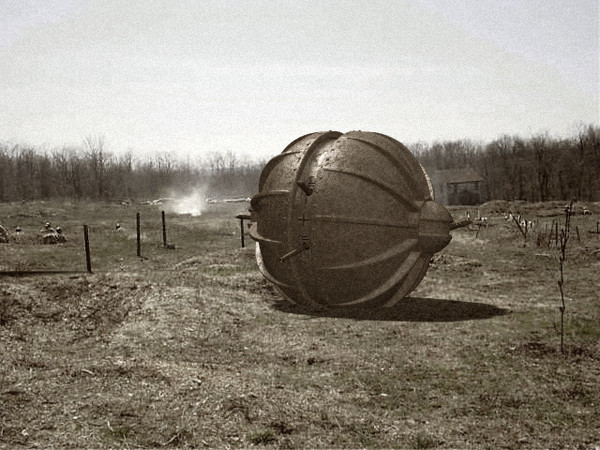While the military has certainly proved adept at developing new and intriguing new technologies, they don’t get it right all the time. In fact, some technologies that our military has tried out in the past have been dismal failures. Lucky for us, most of those failures are hilarious:
You might have heard about this system before: the weapons system that was basically the military’s attempt to make a working heat ray. After researching and developing the system for over a decade—and spending $40 million dollars in the process—the weapon was recalled almost as soon as it hit the streets, after about a month of field work in 2010. Why?

Because the Active Denial System did not unleash a concentrated blast of paralyzing heat that would cripple our enemies…it just kind of gave them all terrible sunburns. This, while admittedly irritating, is not exactly something that will keep you from fighting a war. It’s not even something that will keep you from getting ice cream.
2. The Bat Bomb:
So our generation came up with a bad heat ray—at least we can’t be blamed for the Bat Bomb fiasco. And by Bat Bombs, I do not mean bombs shaped like bats—I mean tiny little explosives strapped to tiny little real-life bats that we were planning to explode over Japanese villagers. This one is all on FDR.

See, back in World War II, President Franklin Delano Roosevelt heard out a pitch by oral surgeon Lytle Adams, who thought that strapping bombs to bats, and then flying those bats into the strongholds of the Axis powers, would be just the advantage our war effort needed to win.
FDR thought the idea was brilliant .
So in 1942 he officially greenlit the project, where Adams and the inventor of napalm—Louis Fieser—designed one-ounce explosive packs for the Mexican free-tailed bats they had collected over the course of a year, which they eventually planned to unleash on Osaka Bay. The bats, which were meant to be parachuted in, would then fly off and roast in Japan’s little nooks and crannies—where the attached military timers would soon blow them, and the villages, to smithereens.
I mean, who knows, it might have worked—if bats didn’t have the ability to fly wherever they please. The bats got loose on the military facility wearing their packs and wound up huddled under a fuel tank…which exploded and incinerated the entire facility.

In true bureaucratic fashion, the Army gave up on the project and fobbed it off on the Navy, who kicked it over to the Marines. The Marines did actually manage to pull off a successful test—at which point somebody sent them a memo I’m assuming read like “Hey, so, we just invented this thing called the atomic bomb that’s gonna be pretty sweet…you can stop blowing up bats now. I mean, you can still blow up bats if you want; we’re just not going to pay for it anymore.”
3. The Tank Ball:
Tanks are incredibly useful bits of weaponry, but like everything, they have their flaws—mostly that they are heavy, cumbersome and pretty much eliminate the option of stealth. Before the start of World War II, a Texan with big dreams thought he could solve all of those problems by inventing the Tank Ball.
It kind of looks like a hamster ball with a snout.

To help out our troops, inventor A.J. Richardson designed a large metal ball that would roll easily over terrain normal tanks would find impossible, as well as offering greater protection to the team working inside. There are just a few problems he didn’t foresee. Like the fact that his design has no windows, so there’s no way for the men inside to see whether they’re driving into the enemies or their own forces, or over a cliff. Or into a tree. This also means that the poor suckers inside the ball would be firing the two guns—which stick out from the side like giant snouts of death—completely blind.
You don’t really need to know much about warfare to know that the sight of your enemy is something you want to cling on to. Or that if you create a giant ball with two little sprouts sticking out, the ball is eventually going to get stuck in the ground.
A for effort though. And by effort I mean hilarity.
While the Cold War was going on, both sides realized that they were neglecting an awe-inspiring, previously untapped secret weapon: the dolphin.

As you might expect, this went about as well as weaponized bats—worse, actually. Both the USA and the USSR started training dolphins to carry out kamikaze submarine missions, lay underwater mines, or fight dolphins that were on the side of the “enemy.” Seems logical. So why aren’t we riding our dolphin friends into battle?
Because both sides forgot how unbelievably intelligent dolphins are. Dolphins, just so you know, have a level of intelligence so close to ours that we’re debating on claiming they’re sentient . And here’s the thing about sentient creatures—most of us tend to get pretty extremely cranky when we realize we’re being taken advantage of. So eventually, the dolphins on both sides realized they were being used, banded together, turned on their trainers, and took their freedom.

My vote is yes on sentience. In case you were wondering.
5. The Puke Gun
This little trick was the result of our military’s attempt to find a non-lethal alternative for crowd control. In 2007, they came up with a flashlight that used flashes of light in order to induce vertigo, nausea, and puking. Not a bad idea, really. So what went wrong?
For starters, the “flashlight” was huge–fifteen inches long and 4 inches wide, to be exact. Also, there's no real way to make sure your enemy actually looks at it, which is the only way it works. You can literally foil this weapon by turning your head, closing your eyes, or just putting on a pair of shades. The military spent $800,000 dollars developing it.

Two years later, two random hackers came up with a $250 dollar version made with a common regular-sized flashlight and $3-dollar LEDs. But the military shouldn't feel bad; you can still beat the commercial version by just facing the other direction.
So, there you have it–five of the most hilariously bad weapons we've ever come up with. Isn’t history amazing?
Advertisement





